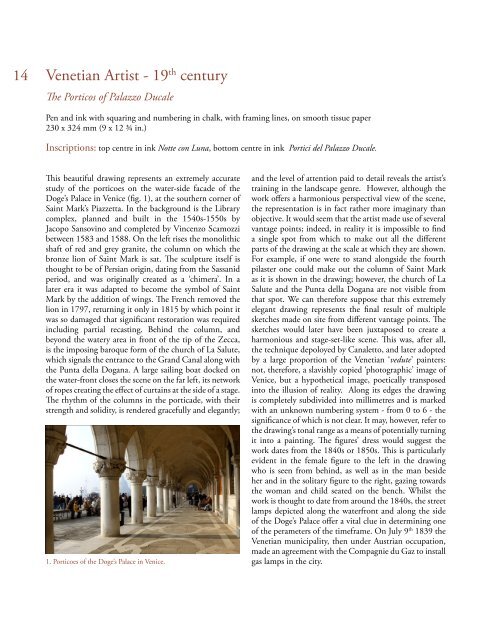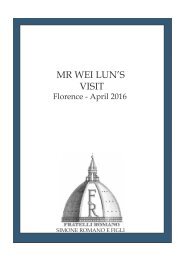A selection of master drawings 2016
- No tags were found...
You also want an ePaper? Increase the reach of your titles
YUMPU automatically turns print PDFs into web optimized ePapers that Google loves.
14<br />
Venetian Artist - 19 th century<br />
The Porticos <strong>of</strong> Palazzo Ducale<br />
Pen and ink with squaring and numbering in chalk, with framing lines, on smooth tissue paper<br />
230 x 324 mm (9 x 12 ¾ in.)<br />
Inscriptions: top centre in ink Notte con Luna, bottom centre in ink Portici del Palazzo Ducale.<br />
This beautiful drawing represents an extremely accurate<br />
study <strong>of</strong> the porticoes on the water-side facade <strong>of</strong> the<br />
Doge’s Palace in Venice (fig. 1), at the southern corner <strong>of</strong><br />
Saint Mark’s Piazzetta. In the background is the Library<br />
complex, planned and built in the 1540s-1550s by<br />
Jacopo Sansovino and completed by Vincenzo Scamozzi<br />
between 1583 and 1588. On the left rises the monolithic<br />
shaft <strong>of</strong> red and grey granite, the column on which the<br />
bronze lion <strong>of</strong> Saint Mark is sat. The sculpture itself is<br />
thought to be <strong>of</strong> Persian origin, dating from the Sassanid<br />
period, and was originally created as a ‘chimera’. In a<br />
later era it was adapted to become the symbol <strong>of</strong> Saint<br />
Mark by the addition <strong>of</strong> wings. The French removed the<br />
lion in 1797, returning it only in 1815 by which point it<br />
was so damaged that significant restoration was required<br />
including partial recasting. Behind the column, and<br />
beyond the watery area in front <strong>of</strong> the tip <strong>of</strong> the Zecca,<br />
is the imposing baroque form <strong>of</strong> the church <strong>of</strong> La Salute,<br />
which signals the entrance to the Grand Canal along with<br />
the Punta della Dogana. A large sailing boat docked on<br />
the water-front closes the scene on the far left, its network<br />
<strong>of</strong> ropes creating the effect <strong>of</strong> curtains at the side <strong>of</strong> a stage.<br />
The rhythm <strong>of</strong> the columns in the porticade, with their<br />
strength and solidity, is rendered gracefully and elegantly;<br />
1. Porticoes <strong>of</strong> the Doge’s Palace in Venice.<br />
and the level <strong>of</strong> attention paid to detail reveals the artist’s<br />
training in the landscape genre. However, although the<br />
work <strong>of</strong>fers a harmonious perspectival view <strong>of</strong> the scene,<br />
the representation is in fact rather more imaginary than<br />
objective. It would seem that the artist made use <strong>of</strong> several<br />
vantage points; indeed, in reality it is impossible to find<br />
a single spot from which to make out all the different<br />
parts <strong>of</strong> the drawing at the scale at which they are shown.<br />
For example, if one were to stand alongside the fourth<br />
pilaster one could make out the column <strong>of</strong> Saint Mark<br />
as it is shown in the drawing; however, the church <strong>of</strong> La<br />
Salute and the Punta della Dogana are not visible from<br />
that spot. We can therefore suppose that this extremely<br />
elegant drawing represents the final result <strong>of</strong> multiple<br />
sketches made on site from different vantage points. The<br />
sketches would later have been juxtaposed to create a<br />
harmonious and stage-set-like scene. This was, after all,<br />
the technique depoloyed by Canaletto, and later adopted<br />
by a large proportion <strong>of</strong> the Venetian ‘vedute’ painters:<br />
not, therefore, a slavishly copied ‘photographic’ image <strong>of</strong><br />
Venice, but a hypothetical image, poetically transposed<br />
into the illusion <strong>of</strong> reality. Along its edges the drawing<br />
is completely subdivided into millimetres and is marked<br />
with an unknown numbering system - from 0 to 6 - the<br />
significance <strong>of</strong> which is not clear. It may, however, refer to<br />
the drawing’s tonal range as a means <strong>of</strong> potentially turning<br />
it into a painting. The figures’ dress would suggest the<br />
work dates from the 1840s or 1850s. This is particularly<br />
evident in the female figure to the left in the drawing<br />
who is seen from behind, as well as in the man beside<br />
her and in the solitary figure to the right, gazing towards<br />
the woman and child seated on the bench. Whilst the<br />
work is thought to date from around the 1840s, the street<br />
lamps depicted along the waterfront and along the side<br />
<strong>of</strong> the Doge’s Palace <strong>of</strong>fer a vital clue in determining one<br />
<strong>of</strong> the perameters <strong>of</strong> the timeframe. On July 9 th 1839 the<br />
Venetian municipality, then under Austrian occupation,<br />
made an agreement with the Compagnie du Gaz to install<br />
gas lamps in the city.





